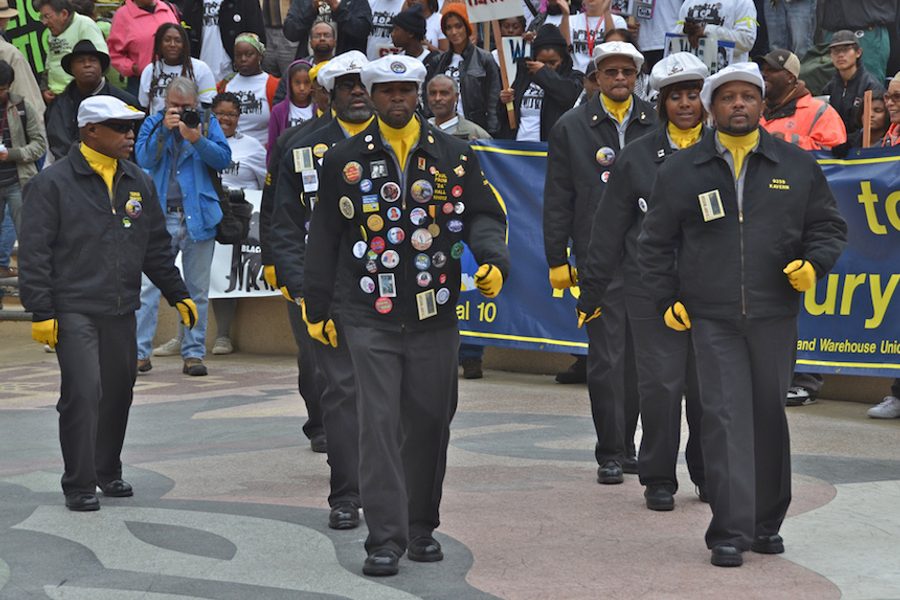Black Lives Matter at Work: New Report Offers Resources for Labor Activists To Fight White Supremacy
Greg Chern

A new report from young workers and organizers on the Movement for Black Lives calls for solidarity, not silence, and offers steps for turning solidarity into action.
Young Workers Media Project (YWMP), a volunteer organization formed at the 2014 Labor Notes convention, hopes their new report will help “dismantle white supremacy where we work and beyond.”
“The Black Youth Project, the Fight for 15, worker groups, youth groups and people all over have been having this conversation for some time,” said James Cersonsky, a volunteer with YWMP. “Now, with the color lines exposed as they are, which side are we all on? And, what are the stories, old and new, that make up the freedom side?”
YWMP’s compiled stories include on-the-ground organizing reports from different cities, interviews with young labor activists of color and teachers, and reflections from fast food retail workers at the frontlines of protest, grad students calling out cop unions, and others.
“The movements connect because we want to free our people and give them a living wage,” says Jeanina Jenkins of Show Me 15 in one section. “They bring more police into neighborhoods instead of more jobs into neighborhoods. We don’t need more police, we need more jobs. They’re slowly connecting.”
Through historical perspective and personal reportbacks, the report mixes moral demands for justice and strategic orientations.
The section “Black Women Organizing the South” jumps back and forth between recent tweets or hashtags and historical anecdotes going back 275 years.
“I want white people, Black people, Latinos, everyone to respond to these horrific, tragic events, but also get to the cause and identifying the system,” writes Leonard Riley of the International Longshoremen’s Association, Local 1422. “Let’s be real. Let’s identify these major things that have their roots in racism and capitalism. The thing that sticks in my head is that labor must lead. This group of workers, with union protections, can wage protests that others can’t. We can’t confine our energy to just going to work.”
Martese Chism, RN Case Manager at John H. Stroger, Jr. Hospital of Cook County, Chicago, places the question as an existential one for labor. “If the Labor Movement wants to be great again, the Labor Movement must understand that Black Lives Matter. Either we all fight together, or we all get destroyed together.”
Jennifer Epps-Addison offers a direction for ramping up that fight together. “The statistics show us that the fastest growing organizing is among Black women — and campaigns organized by Black women. This is where we need to invest our resources in building power. We are demanding representation and ownership over our strategies and the direction of the organizing.”
“I believe the resource guide is a much needed invitation for all of us to face the question: how can Black Labor Power model co-resistance and complicity with the expansive, intersectional Movement for Black Lives?” said Jason Tompkins, an organizer in the Chicago chapter of Black Lives Matter.
In August, the Chicago chapter hosted an event called “Black Trans Lives and Labor,” with an accompanying zine analyzing the movement back and forth from formal work settings to informal sex work common for Black trans workers. Jas, author of the zine and a speaker at the August event, asks, “How many Trans women of color doing survival sex work even think about joining a union, or struggling for wages?”
Tompkins felt that it’s important to focus upon “the criminality and violence Black Trans women and gender non-conforming folks are forced to navigate while pursuing and engaging in work,” an aspect missing from the YWMP report.
Many aspects of this question are being explored in a recent explosion of writing and strategizing on Black Lives Matter and the labor movement.
Released in April, “And Still I Rise: Black Women Labor Leaders’ Voices, Power, and Promise” summarizes interviews with 27 and surveys of hundreds of Black women in the labor movement, including Epps-Addison.
At the July convening of the Movement for Black Lives in Cleveland, many labor organizations were present, and labor staffers led a session on highlighting Black Lives Matter in the labor agenda. Meanwhile, the Coalition of Black Trade Unionists released “A Future for Workers: A Contribution from Black Labor,” seeing it as the first steps for renewing a dying labor movement and building “an agenda that focuses on power rather than on grievances.”
And in September, Jacobin and CounterPunch published articles within days of each other on the history and the fits-and-starts organizing around the intersection of Black liberation and the labor movement.
Tompkins sees this developing conversation as connected to a real strategic need.
“We need to build from getting supportive union resolutions passed, and having union presence at marches and rallies, to wielding union power toward the clear, unapologetic demand to divest tax dollars and state resources away from violent, militaristic police control and occupation over our communities.”
Coinciding with the need to control state repression is a need to protect public sector workers from austerity, which especially threatens Black unionized workers. A recent report by Ruth Milkman and Stephanie Luce reinforced that Black workers are overrepresented among public sector workers, “19.7% of Blacks and 14.9% of non-Black work in the public sector,” and that this dichotomy has heightened in New York since the recession.
In addition, this conversation could also stem from concern about renewal and generational transition in an aging and shrinking union movement, with Black Lives Matter representing a rising, younger wing of the Black liberation movement.
There have been concerns and hopes about the relationship of younger working class people to unions, a majority of whom view unions favorably. But if millenials are expected to bring in a millenarian union utopia, there are signs that they will want to bring along with them a new vision of society and social justice — one in solidarity with the Black Lives Matter movement.
“We see a real national trend of younger workers really pushing the labor movement to the left in a number of ways,” said Katy Fox-Hodess former campus chair of UAW 2865 at UC Berkeley in an article for The Atlantic. “We have to stand up on issues of racism, xenophobia, women’s issues, LGBT issues, foreign policy issues — we have to have a broader politics.”
Despite the strong interest in unions among young workers and Black workers, unionization rates are still declining nationally, especially among Black workers. Given Milkman and Luce’s findings that the increase in earnings from being unionized is greater for Blacks than for non-Blacks — not to mention the fringe benefits that go along with unionization — a decline in unionization among Black workers has especially damaging impact on the power of unionization for all workers.
Still, the interest is palpable. After YWMP released their report, they immediately began receiving additional resources. And they’re happy to keep the conversation going.
“People are often the best reporters of their own experiences,” they said. “There’s a lot of listening to do. Short of that, there’s even more yelling to do — and that people are doing inside and outside the labor movement.”

I hope you found this article important. Before you leave, I want to ask you to consider supporting our work with a donation. In These Times needs readers like you to help sustain our mission. We don’t depend on—or want—corporate advertising or deep-pocketed billionaires to fund our journalism. We’re supported by you, the reader, so we can focus on covering the issues that matter most to the progressive movement without fear or compromise.
Our work isn’t hidden behind a paywall because of people like you who support our journalism. We want to keep it that way. If you value the work we do and the movements we cover, please consider donating to In These Times.



